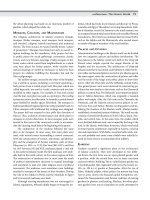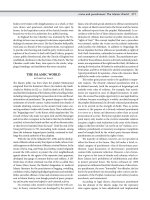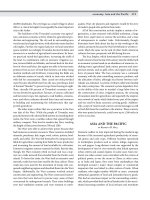Encyclopedia of society and culture in the medieval world (4 volume set) ( facts on file library of world history ) ( PDFDrive ) 202
Bạn đang xem bản rút gọn của tài liệu. Xem và tải ngay bản đầy đủ của tài liệu tại đây (77.96 KB, 1 trang )
children: Europe 175
A Royal Child in India
Medieval Indian monarchs were usually members of
the Kshatriya caste, composed of warriors and government leaders. A king often had many concubines
living in a harem. Children of the king spent their early
childhoods in the harem, where they played games.
Sometimes the king took his harem, including the
children, out on excursions that included bathing in
a river. When they were deemed old enough, children
were removed from the harem and put in the care of
a tutor.
The birth of a crown prince was cause for celebration. For about 10 days the king and his subjects
celebrated with parties, dancing, and music. Every
day of his childhood the crown prince had his body
rubbed with yellow oil to make him look golden. He
wore a necklace of tiger claws to ward off evil. When
he was removed from the harem, the crown prince
began training to become a leader. From the age of
three he learned the rules of conduct for his caste and
studied sacred books. As he grew bigger and stronger, he practiced horseback riding and the skills of
a warrior in addition to studying academic subjects.
At age 11 he began training in how to run a kingdom
and how to manage the national bureaucracy. When
his tutors considered him ready he was placed in a
military unit, and eventually his father sent him to
fight in a war. By the time he was a young man he was
expected to command a military unit.
If a king had only daughters, sometimes the eldest daughter was raised as if she were a crown
prince. She was expected to marry and have a son,
who would become part of her father’s line of kings.
A king might adopt a son who by custom would have
all the rights, privileges, and duties of a natural-born
crown prince.
was given a name to use until the real one was revealed. At
night the family kept a lamp lighted beside the child to ward
off evil.
Children of the poor were put work in the family business as soon as they could walk. Education was very much
desired by children of all social ranks because only through
education could they learn how to live fulfilling lives. In general, a Hindu child was expected to learn the rules of his or
her caste, especially those regulating moral behavior. With
a good education a girl could aspire to marry a well-to-do
husband or manage a business of her own. A boy could hope
to become a leader in his community.
Europe
by
Sophie Oosterwijk
In the medieval period childhood was a clearly recognized
phase of human life. The “ages of man” were a popular theme
in art and culture. Ranging from three basic ages (youth,
maturity, and old age) to more extended schemes, depictions
show the different stages of life from birth until death. Many
variations of this theme included separate stages for infancy,
childhood, and adolescence or youth. Artistic renditions may
depict infancy as a swaddled baby or a toddler behind a baby
walker and childhood as a young boy at play.
In real life there were also specific stages of childhood
that marked a transition. Medieval infants often were weaned
relatively late, at the age of two or even three, but they remained in the nursery during this first age of infancy. Children usually started their elementary education or training
at the start of the age of childhood, around seven and grammar school education or formal apprenticeships in their early
teens. There was no uniform age to mark adulthood. Children might marry young: Legally, girls could marry as early
as 12 and boys as early as 14, though laws varied and did not
necessarily apply to other aspects of life. An adolescent could
still be technically a minor in terms of inheritance or legal
responsibility.
Birth and child care are among the topics discussed by
such medieval authors as Bartholomaeus Anglicus (fl. ca.
1220–40) and the Tuscan physician Aldobrandini of Siena
in the 13th century, though in reality midwives rather than
physicians assisted mothers during childbirth. Newborn babies were expected to be bathed and cleaned after birth before
being swaddled tightly in cloths or bands with the intention
of keeping them warm and allowing their limbs to grow
straight. Many late medieval tomb monuments show images of swaddled infants, or so-called chrysoms, which usually commemorate children who died in early infancy. The
need for hygiene is often emphasized in medieval medical
handbooks. It is impossible to prove how often children were
washed, but there are many literary references to bathing as
well as depictions in medieval art of infants being bathed in a
tub by their mothers or nurses.
Birth was a hazardous event for mothers and children
alike. Many miracle stories describe parents praying desperately for a stillborn baby to revive, at least long enough to allow
baptism to safeguard the child’s immortal soul. Birth rates
were generally very high, but so were infant mortality rates,
and therefore many parents experienced child loss. The high









